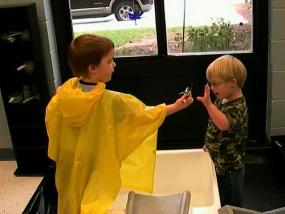Find the Story

When observing children in class or in a video clip try to find the story. This concept of "story" will serve you well. Do not be satisfied with the list-like structure of a report. Reports contain no unfolding of a struggle, no protagonist or antagonist, no resolution of a struggle, no irony, surprise or human interest. After looking at this video clip of Evan and John playing together in the water table, one could write a report or one could find the story.
Here is an example of a report. We might call it, "Learning to Cooperate".
Evan and John play together in the water table. Evan (blonde on the right) places his hand under the stream of water that John is making using a tube. John steadies the tube so Evan’s hand can find the water stream. The boys laugh several times and expand their game to using fish to splash water on each other in a playful way. This video suggests that Evan and John are good friends and that they know how to follow and lead, as the situation requires.
Here is an example of a story. We might call it, "From Separate to Together”.
Evan, the blonde child on the right, watches the water pouring from John’s tube. At first he plays with the stream without paying much attention to John. But John attends to Evan and makes sure that Evan can reach the water stream. When John fills the tube with water again, Evan accepts this as a cue that the next round of the game has begun. He stands ready to extend his hand. The boys become more connected as seen in their laughter and smiles at the camera. They even expand their game to dueling with their fish, and in so doing shift from exploring the physics of water to enacting a symbolic play of menacing sharks.
Here is another example of a story. We might call it, "The Importance of Imitation".
Evan, the blonde child on the right, often uses his great ability to imitate as a mode of play with another child. Watch how Evan bows down to the table’s edge the same way that John does and listen to how he echoes the sound that John makes when he offers Evan a fish. It appears that Evan interprets John’s laughter as a sign that John is enjoying the game and imitates this laughter as a way of communicating to John that he is enjoying the game as well. Evan pantomimes his laughter by holding his hand over his mouth and bending forward. Evan’s imitation of John’s laughter can be interpreted as the strategy that he uses to connect with John, reasoning that this connection with John will sustain the play.
What are the differences in the report and the two stories? While the report suggests to us that John and Evan are good friends, able to assume the roles of leader and follower during play, the story explains how the relationship between the boys unfolds, i.e. through John’s attentiveness to Evan, to which Evan responds (Story #1), and through Evan’s imitation of John’s actions, including laughter, designed to keep the play going (Story #2). In your opinion, what else might differentiate the report from the story?
Keywords: Fours, Child-Child, Communication, Maintaining Play, Imitation
Length of stand alone master video clip: 1 minute 56 seconds
